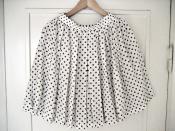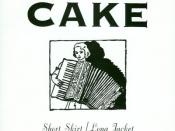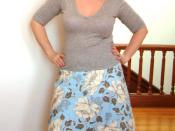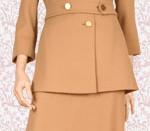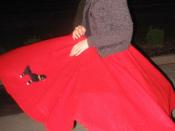Cream Cape Suit The 1940's was a glamorous period in fashion even through World War II when government started a rationing program, which put restriction and restraints on the amount of fabric a person could use on a garment and the types of fabrics available for use. Practical functional clothing like trousers, coveralls and slacks became the accepted dress for women as they entered into the workforce and took over jobs formally held by men. Clothing regulations known as the L-85 restricted the quantity of fabric that could be used on clothing, limiting fashion and causing styles to freeze. (www.geocities.com).
By the beginning of World War II cotton, linen, silk, and wool were most popular natural fibers being used until they became very limited after America joined the War. Nylon, a popular synthetic fiber, was being used for military purposes and became scarce and abandoned by women. Instead women were going bare legged or putting make up on their feet and painting a line down the center back of the leg to look like they had stockings on.
Designers had to search for available fibers Acetate and Rayon were synthetic fibers being used for most women's clothing (cti.itc.virgina.edu).
The L-85 regulation stated that the fashion industry must maintain the broad shoulder silhouette and gave specific instructions on cuts for every outfit permissible. Dress skirts could have up to"ÃÂ 72 inches at the hem"ÃÂ(cti.itc.vergina.edu), suit jackets were allowed up to 25 "inches in length"ÃÂ(cti.itc.vergina.edu). Pants were allowed up to "19 inches in circumference at the hem"ÃÂ(citi.itc.vergina.edu). Cuffs, sashes, or hoods were not allowed on shirts. Jackets were only allowed one back pleat, and dresses were allowed only one pocket. Manufacturers were also "required produce 85%"ÃÂ(cti.itc.virgina.edu) of their output to utility garments, and "only 15% of output"ÃÂ(cti.itc.virgina.edu) was allowed to be on the free market, which severely limited design creativity. Shoppers were encouraged to sport the utility look, which was manipulated by designers to look attractive and to buy conservative, like a day dress that could double as an evening dress. (cti.itc.virgina.edu).
Several years after World War II certain fabrics were still limited and a shortage of material evident, but women wanted to break away from the tubular skirt and the male trousers look. Women wanted to leave behind the restrictive dressing (Laver 1973). The classic look, which consisted of two-piece suits and cardigan jackets, was seen during the post war years. Women's suits continued to be cut with broad shoulders and skirts stayed slim and just below the knee. (Bigelow 1979). As men returned from war and women returned to the home, women tired of the tubular look of the war era, and women's suits were getting boring with no designs being incorporated into clothing.
Nalia Hylin donated this cream knee length suit with blue embroidery made of wool from 1946 to the University of Hawaii At Manoa costume collection in 1985. The skirt is similar to those worn after the War, but the top consists of a very detailed embroidered cape. The cape of the suit resembles military outfits but with a touch of femininity. The appliquÃÂé on the back of the cape resembles a Hawaiian quilt design and uses a lot of excess fabric, which demonstrates the want for detailed fashionable clothing. Women were ready for change.
A year later in 1947 a designer named Dior launched his "ÃÂNew Look'. Diors "ÃÂNew Look' helped to steer women away from the short skirt square padded shoulder tubular appearance. The "ÃÂNew Look"ÃÂ had narrow shoulders, a slim waist that was in the right place, a new emphasis on the bust, and a long skirt with a wide hem (Contini 1965). The wide acceptance of Dior's "ÃÂNew Look' proved that women were ready for change. The "ÃÂNew Look' moved women from comfortable clothing to a form fitting tiny waist and a big hip silhouette.
Accession #- 1985.10.4 Bigelow, M, S. (1979). Fashion In History Western Dress Prehistoric To Present.
Minneapolis Minnesota: Burgess Publishing Company.
Contini, M. (1965). Fashion: From Ancient Egypt To The Present Day. New York: Crescent Books.
Laver, J. (1969). The Concise History of Costume and Fashion. Great Britain Jarrold and Sons ltd.
"1940's Fashion"ÃÂ 1940's Fashion September 26, 2001; http://cti.itc.verginia.edu/~kmr3c/fashion/fashion2html "Web Studio"ÃÂ Style Descriptions September 26, 2001; Http://www.geocities.com/soho/coffeehouse/6727/introduction.html.
